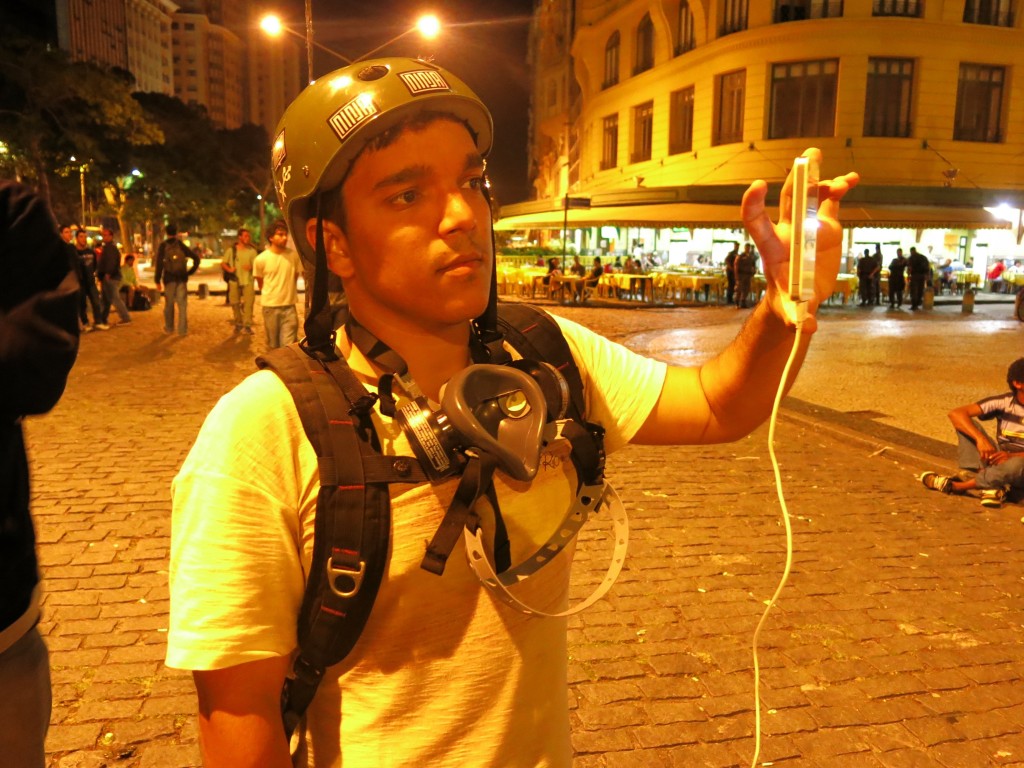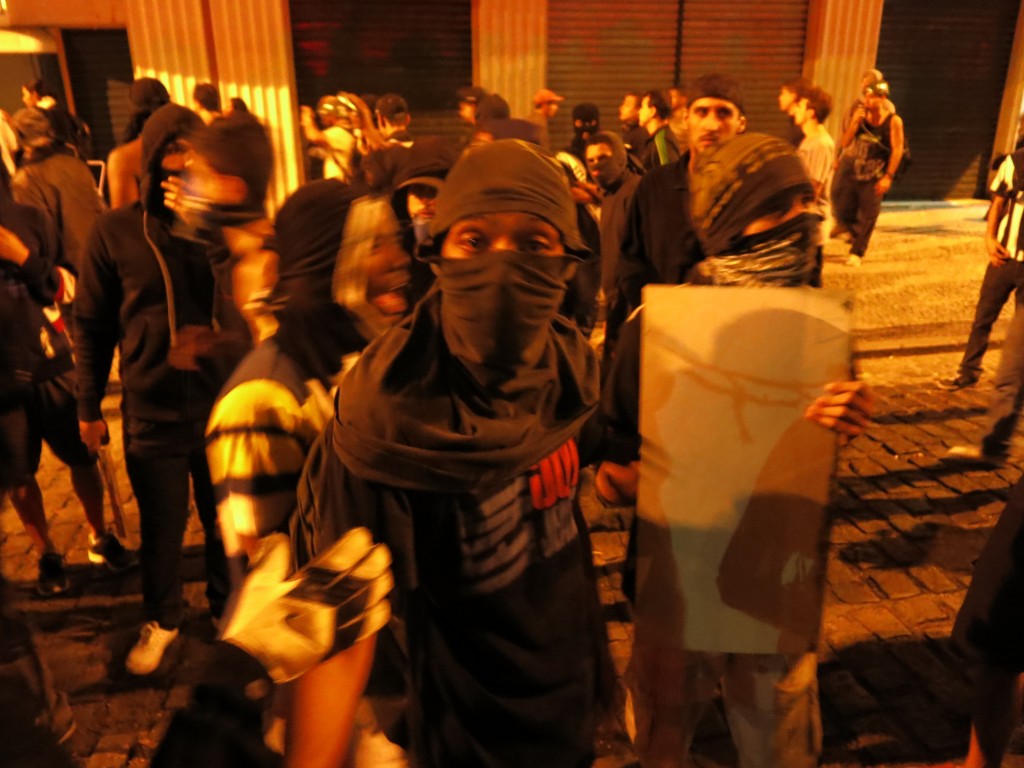Dom Phillips reports from inside Brazil’s most recent protests in Rio and talks to a ‘Black Bloc’ style protester, whose clashes with police have increasingly dominated coverage of the demonstrations and may even be scaring other protesters away. All photos Dom Phillips
By Dom Phillips
There were seven protests planned in Rio de Janeiro on Saturday – Brazilian Independence Day, which had been billed nationwide as a day of mass protest. Not one pulled more than, at most, a couple of thousand people. Sociologists and academics have been saying this week that the violence has scared off the big crowds seen in June, and that protest groups have splintered. What happened in Rio, especially given the heavy police repression that followed a huge demonstration June 20 here, would seem to bear that out.
I wasn’t on Presidente Vargas Avenue in the morning when a small group invaded the Independence Day military parade and police set of tear gas. TV Globo replayed scenes of the invasion repeatedly, along with images of people they described as ‘anarchists’ burning Brazilian and American flags at the Zumbi Monument in Central Rio.
On Saturday afternoon I was in Cinelândia, central Rio, where the steps of the city council chamber have become an impromptu protest camp over the last weeks, and passing office workers step gingerly around protestors’ tents.
A few hundred protestors were milling around, but the only sign of the demonstration due to begin at 2pm was a handful of animal rights activists, one of whom was dressed as a pink rabbit. The next big event was 5pm near Guanabara Palace, seat of state governor Sérgio Cabral’s palace.

I reached the demonstration where a couple of thousand people were gathered at the exact moment the police started firing tear gas and stun grenades. There was a panic as hundreds of people started running back down the Rua das Laranjeiras towards the Lago do Machado square.
The air was thick with gas. I’ve been tear gassed by Rio police half a dozen times at demonstrations in public places, and this was the strongest I have felt it. People reacted as they usually do: they get angry, they cry (that’s why it’s called tear gas, it stings and makes the eyes water), they scream that the police are cowards.
And some of them, usually young men, usually wearing masks, start breaking things. This time it was the glass window of a bank foyer, where the cash machines are, a bus stop, a street light. As the crowds reached Lago do Machado, some of the masked young men began mingling with the traffic, stopping cars, lighting a fire in the street.
A crowd of onlookers stood on the steps of a nearby church – some hurried off nervously, others filmed on their cell-phones. Some of the protesters began trashing the glass frames on a bus shelter that cover up advertising billboards. For ten minutes or so, as the police made their way down, there was a little pocket of anarchy on that street corner.
It did not last. Rarely do protesters actually engage in combat with police – instead they throw stones from a distance, and light fires from rubbish. The police concentrate on shows of strength – in this case, a squad of them drove around on motorbikes, others rode black police jeeps, wearing their Robocop riot gear: helmets, shields, protective rubber pads and breastplates.

The ‘anarchists’ have their uniform too: masks, black T-shirts wrapped over their heads, hooded tops, black jeans, heavy metal and punk T-shirts. Everybody calls them Black Bloc and say they are inspired by the international protest tactics of the same name.
One black-clad youth holding a crash helmet asked me if I thought trashing banks and bus-stops was valid. “It is not vandalism,” he told me. He did not want to give his name. I got out my tape recorder.
“The financial institutions abuse the rights they have to charge us. The biggest enemy of Brazilians is the banks,” he said. “Every decision the government takes is looking at banks’ profits.” Then he ducked off as riot police in helmets began firing more tear gas in our direction.
Later in Cinelândia, surrounded by cameras, another group of ‘anarchist’ youth dressed in black shouted amongst themselves as they tried to decide what to do. A hundred or so headed off towards Lapa – a popular nightlife area, stopping by a skip to pick up staves of wood as they went, which they waved triumphantly in the air while chanting. A squad of riot police hurried after them.
The scene became increasingly surreal when a woman waving a flag took it on herself to lead the riot police procession, as if it was a carnival parade, while shouting, apropos of nothing: “Save Pope Francis!” Everybody did their best to ignore her: she did not fit into the script that both sides were acting out, in a protest novela that seems to have lost the plot.
Have increasing levels of violence put Brazilians off protests? This is the question being asked this week in the Brazilian media, in posts like this from UOL, in which Michel Zaidan Filho, sociologist and professor at the Federal University of Pernambuco, said: “Now there has been a radicalization, and many people did not go because of the criminality of the protests. The majority don’t want to face police, bombs.”
Finally, the riot police decided to move on. A motley crowd of onlookers jeered – it is impressive how unpopular the police are in Rio. “Bow wow wow, Cabral’s little bitches!” the mob shouted. The police did not like that much, and fired more tear gas in the air as they left.
More photos below







